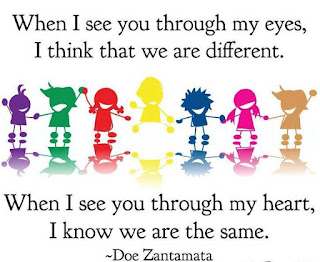when I think about working with Children and families from diverse backgrounds, my main focus is their well-being. Due to the fact that working with people with different cultures and backgrounds, it is sometimes rather challenging to meet their needs. My hope for working with children and families is that I am able to establish a relationship/partnerships with the individuals and give thrgive them a sense of safety and security by decorating my classroom that displays a welcoming climate that shows that their kind are accepted and appreciated as well. I believe that these first aspects are the key to teaching and reaching out to children and families.
My goal in working with children and families is to see that needs are met for all, regardless of family income, living status, race and even poverty stricken families and much more. I would love to be an advocate and early childhood professional that steps up to make an attempt in reducing biases and inequities in the early childhood field.
I must say that it has been a pleasure to work with each and everyone of you all. Thanks for your support in my blogs and discussions, and I wish you all well in your next course :)
Saturday, December 17, 2016
Saturday, December 10, 2016
Start Seeing Diversity Blog: Creating Art
“In our society, many issues divide people. These include age, gender, sexual orientation, family composition, economic class, physical abilities and characteristics, race and ethnicity, and many others.” (Laureate Education).
There
was a time when I didn't quite understand myself,
and
the misunderstandings and feelings of hurt I've caused on everyone else.
Being
exposed to the negativity from those around me and from a different race,
I
began to feel incomplete and lost control of myself.
With
the passive aggressions from those, I held within,
I
began to seek revenge and hold grudges on other races, and refused to let
anyone else in.
Many
struggles of racism came, but the fact remained,
that I
must devise a plan, to keep this cycle from being the same.
After
taking time to think and analyze all of the things that could possibly hurt me,
I also
began to consider others as well, and this method was a start to set me free.
From
the guilt and shame on backing away, judging those who actually meant no harm,
I
faced these challenges on by one, and my emotional walls of protection were
finally disarmed.
Thanks
to my support team, we stuck together,
assisted
each other and became better than ever.
To
keep the world from being wrapped up in this circle of socialization,
we as
a people must reach out to others to reduce anti-bias and form better organization
Saturday, December 3, 2016
Start Seeing Diversity
Bias based
on physical disabilities or characteristics, or ableism, is any attitude,
action, or institutional practice that subordinates people because of a
disability or other physical characteristic. (Laureate Education) I can recall
a time where I was at a basketball game with my three nephews and
sister-in-law. While sitting in the bleachers, we saw a young man that appeared
to have down-syndrome, come sit beside us. The young boy began shouting,
cheering and clapping along with his parents. My youngest nephew started to
stare at the young man out of curiosity. The next thing that I can remember is
him pointing at the young boy and asking his mother, “ma, what’s wrong with
that boy right there?” My sister-in-law responded, “Who?” and my nephew responded,
“RIGHT THERE!” pointing again, with a smirk on his face as if he wanted to
laugh. By that time, the parents noticed that my nephew was pointing at him and
so did the young boy as well. Although the parents looked slightly angry, the
young boy actually smiled at us. My nephew got scolded by his mother and made
him leave the game and took him home.
Being that my nephew was only seven
at the time this incident occurred and may have actually had a question that he
needed clarity on, I honestly do not think that his mother handled the
situation in a correct manner. My sister-in-law seemed as if she was more embarrassed
on her end and did not want to be in the presence anymore, along with my
nephew. After they left the game, I leaned over and apologized to the parents
of the young boy and asked if they mind if he sat with us. After the parents
accepted the apology, the young boy came and sat with us, I bought him popcorn,
and he and my other two nephews enjoyed the rest of the game. By me taking
action to attempt to resolve this issue, I felt better about myself and for the
young boy because I knew at that time that we are all different in some way
from one another.
I believe that an anti-bias educator
would have pulled my nephew to the side and explained the young boy’s uniqueness
and inform him to not point out people’s differences from him in public, by
fostering leadership of targets (Harro 2010). Understanding that children do
not yet understand that there was practically nothing “Wrong” with the child,
but just not the same as him, I think that the anti-bias educator could have
made an impact out that situation that would have changed his perspective of
diversity for the rest of his life.
References
Harro, B. (2010). The cycle of
Liberation. In M. Adams, W. Blumenfeld, C. Castaneda, H. W.
Figure 7.1 on p. 53
Subscribe to:
Posts (Atom)

